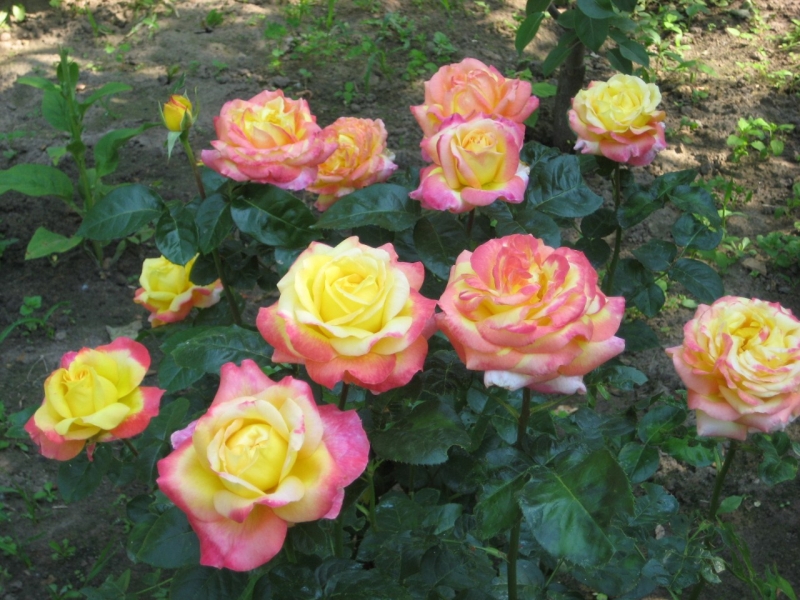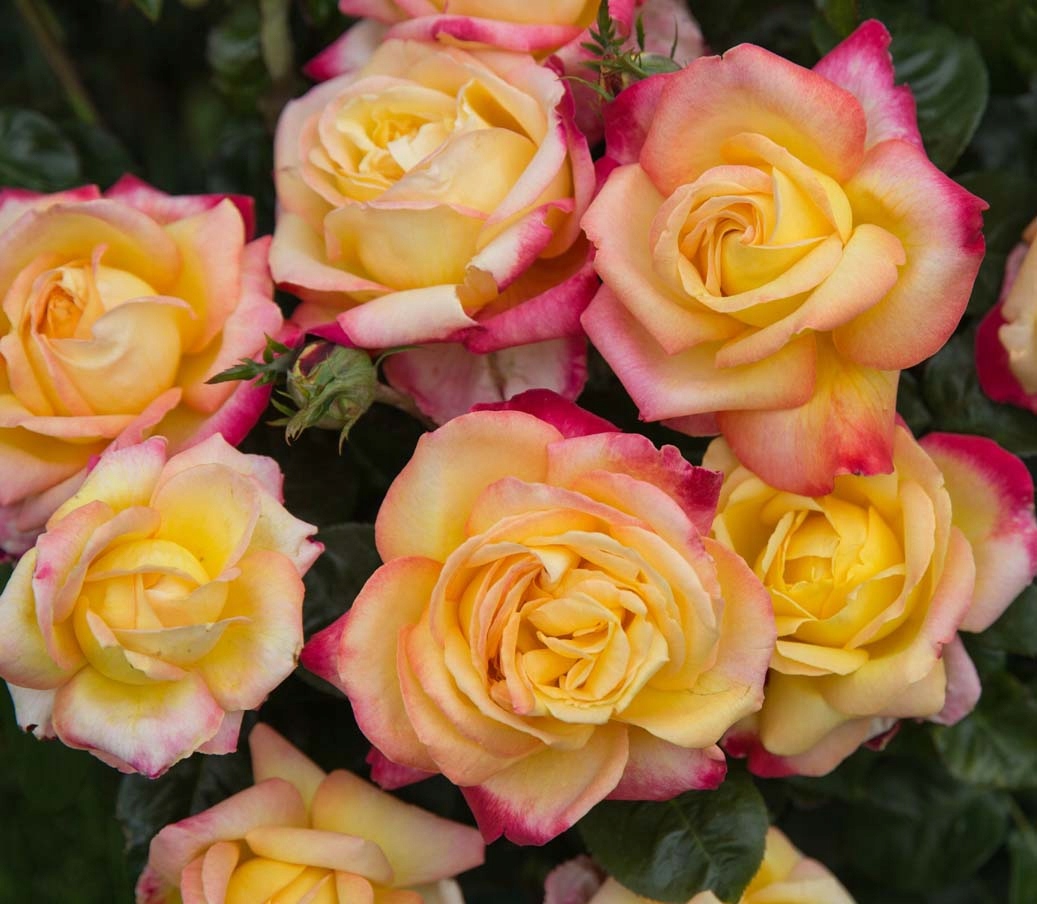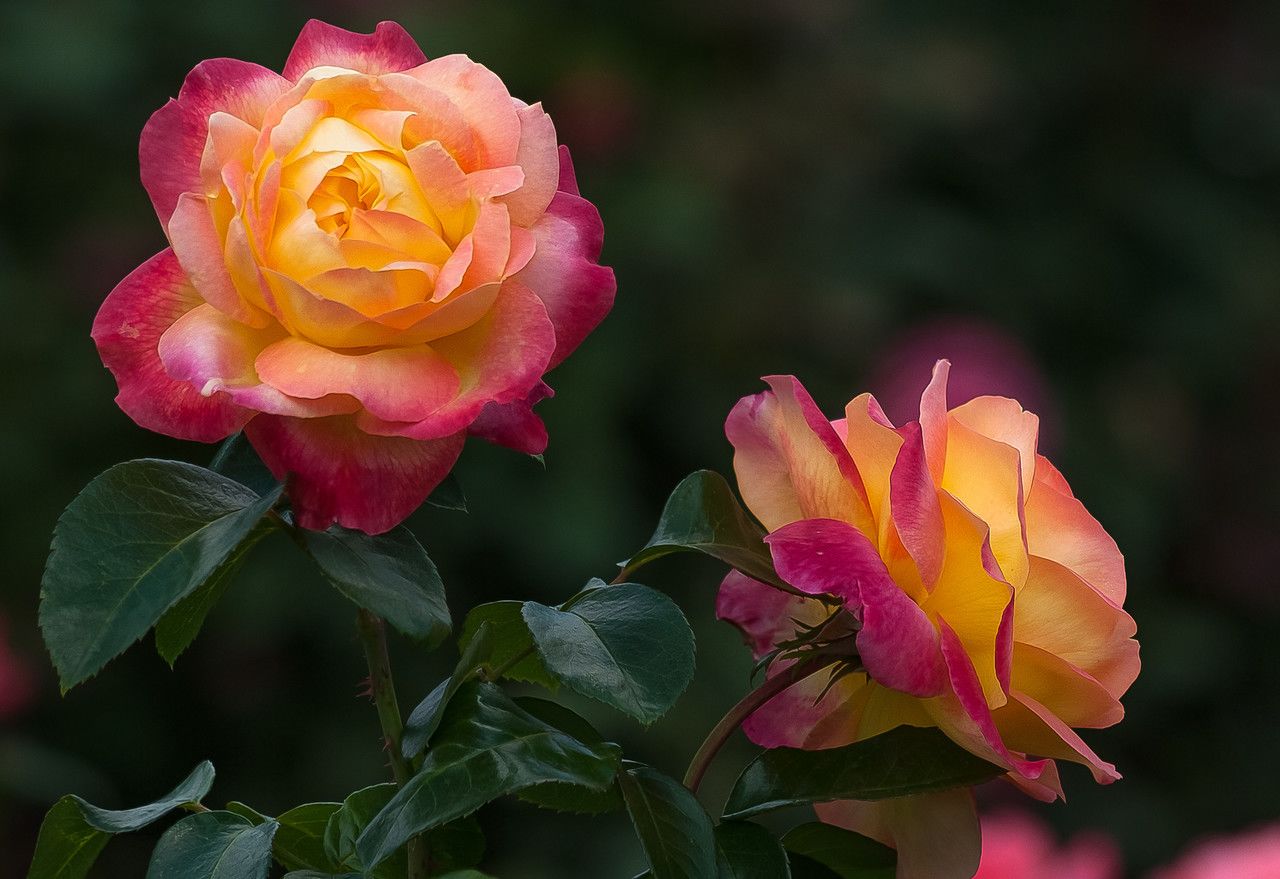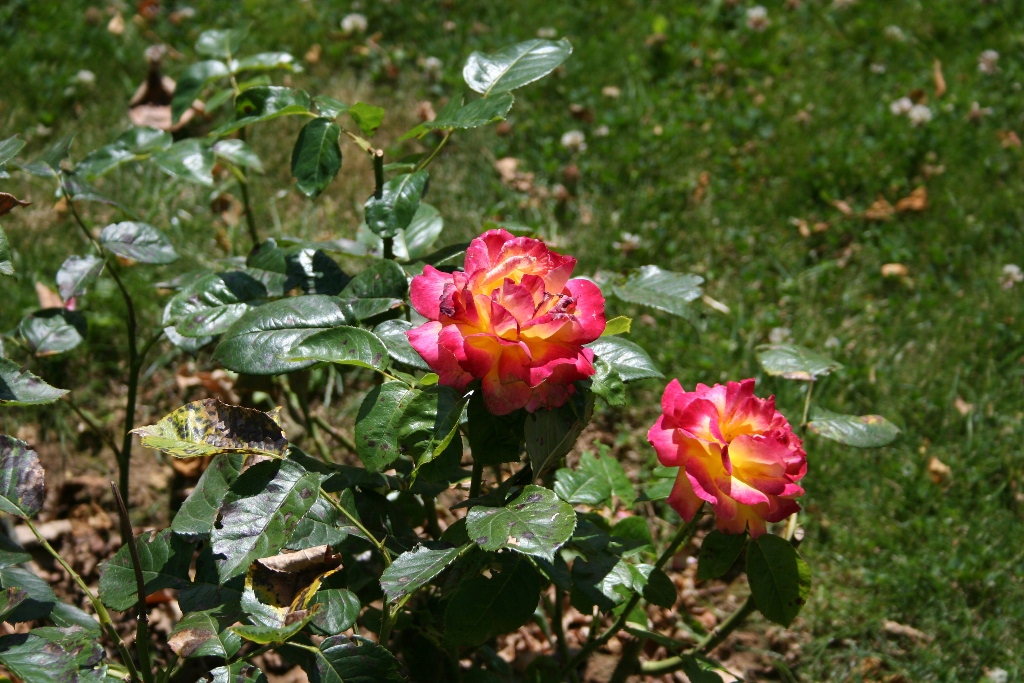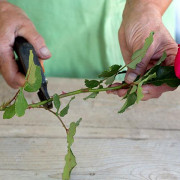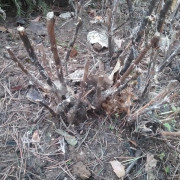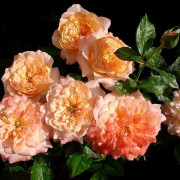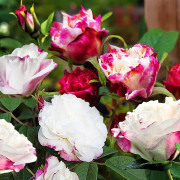Rose Orient Express (Pullman Orient Express) - what is this variety
Content:
Rose Orient Express pleases with abundant and lush flowering. The sophisticated appearance of the bushes will fit perfectly into any landscape design. Famous French breeders worked on the breeding of a hybrid tea variety of a rose. Thanks to their painstaking work, the thorny plant variety is not susceptible to diseases and pests. Caring for the bushes is simple, which is an undoubted advantage.
Description
The goblet flowers of the Pullman Orient Express tea rose are colored in a variety of colors. When opening the buds, you can take a closer look at the amazing combination of the palette. The core of the flower is painted in creamy yellow tones, the edging of delicate pink petals is painted in dark crimson shades. The diameter of the opened flowers can exceed 15 cm. The height of the shoots is in the range of 125-150 cm. The upright shoots are literally dotted with dark green leaf plates. The diameter of the bushes reaches 100 cm.
The flowering of the variety lasts a couple of weeks. During this period, the garden area is filled with a delicate aroma.
The main advantages of the Eastern Express rose variety include:
- lack of predisposition to burnout petals;
- frost resistance;
- long lush flowering.
The main disadvantage of the Vostochny Express hybrid variety is the impossibility of growing it in an apartment.
You can admire photos of amazing flowers in any gallery of roses.
Use in landscape design
Landscape designers often use the Pullman Orient Express rose when landscaping a site. The stem is planted not only among other perennials, but also near non-flowering hosta-type crops.
Landing features
When choosing a place for planting seedlings, it is worth giving preference to well-lit areas. Planting bushes in drafts is unacceptable. Planting work can be carried out both in mid-April and at the end of September.
The soil
For planting work, it is worth using a mixture of black soil and loam, which will enrich the plant with nutrients. It is important to take into account that the groundwater level is not higher than 100 cm. The recommended level of soil acidity is low.
Planting seeds
Seeds purchased in a specialized store are subject to stratification, which contributes to the acceleration of pecking when they enter the nutrient soil. Stratification takes three weeks. The seeds, laid out between the pieces of wet foam rubber, are placed for a specified period of time in the refrigerator.
Containers for planting are poured over with boiling water. After drying, the containers are filled with a soil mixture consisting of:
- sod soil;
- humus;
- river sand.
The soil is spilled with a solution of potassium permanganate for the purpose of disinfection.
Planting seeds
Planting containers are filled with soil. A layer of snow is laid on top of the ground. The layer thickness should not exceed 7 cm. Seed material is laid out on the snow mass. As the snow melts, the seeds are moistened. A film material is stretched over the container. The film is removed daily for 30-40 minutes. for the purpose of airing.Two months after the emergence of seedlings, you can cut the seedlings into separate pots.
Planting seedlings
When purchasing seedlings, you should carefully examine the root system and stems. The presence of damage and signs of decay is unacceptable. The leaf plates of the seedlings should be dense. The stems should have more than two branches.
Step-by-step instruction:
- The selected planting zone is dug up. A small part of sand and humus is introduced into the ground, which contributes to an increase in the airtightness of the soil.
- A hole is dug with a depth of 45-55 cm.
- A drainage layer is laid at the bottom.
- A seedling is lowered into the recess. The root system is leveled.
- The pit is covered with a layer of soil. The soil around the seedling is compacted and moistened. 2 buckets of water are poured under each bush.
- The surface of the earth is mulched. For this purpose, sawdust and peat can be used.
Plant care
Rosa Orient Express is thermophilic, so the temperature should be within 17-22 ° С. Seedlings must be watered systematically. Experts recommend moistening the soil every 2-3 days. Warm settled water is used for humidification.
Top dressing
It is recommended to use horse manure as a top dressing. In addition, roses require the systematic application of phosphorus-potassium fertilizers during the budding period. Weed the soil every two weeks to prevent weeds from overgrowing.
Pruning
Perennial green space needs preventive and formative pruning. For prevention purposes, shoots are cut from the bush, which die off, broken branches and affected by infection or pests. In the process, it is necessary to make cuts directly at the base of the stems.
Transfer
The transplant can be carried out both in the spring months and in the fall. After the 20th of October, it is not worth replanting the bushes, since they will not have time to get stronger before the onset of frost. It should be borne in mind that during the flowering period, the bushes are not transplanted.
Preparing for winter
In early October, experts recommend preparing the bushes for the cold weather. For this purpose, all leaf plates are cut from the green space. The bushes are processed with copper sulfate, and 1/3 of the length of the shoots is cut off. The branches are pressed against the surface of the earth. The bush is covered with spunbond. Boards and spruce branches are laid on top of it.
Bloom
Rosa Pullman Orient Express pleases with abundant flowering throughout the summer. Dense double flowers are painted in bright shades. Their diameter can reach 14 cm. During flowering, it is important to systematically inspect the plantings. Buds beginning to wither should be pruned.
In some cases, flowering may not occur. The cause of this trouble can be:
- lack of sunlight;
- wrong landing zone;
- improper pruning. In the spring, it is unacceptable to cut the bushes strongly;
- lack of proper care. It is important to systematically feed the bushes to prevent them from weakening;
- bacterial damage.
Reproduction
To preserve the varietal characteristics of the Pullman Orient Express rose, it is recommended to propagate plants in two ways:
- cuttings;
- dividing the bush.
To use the cuttings method, you must first start harvesting cuttings. Young shoots are cut from the bushes at an angle of 45 °. The twigs dipped in the root are planted in containers with fertile soil. A film is stretched over the container, which is removed daily for 10-15 minutes. for the purpose of airing. Every day the soil is moistened with a spray bottle. After 2-3 weeks, the cuttings take root. After a month, they can be transplanted into open ground.
Diseases and pests
Despite the resistance of the Pullman rose to diseases, the bushes against the background of improper care can suffer from:
- rust, which appears as brown or orange spots on the leaf plates. Disease can occur due to high humidity levels. To cope with the trouble, you will need to carry out the processing of green spaces with a profit;
- brown fungus that destroys not only flowers, but also branches. For the treatment of roses, you will need to use drugs like foundation;
- infectious burns, which may be indicated by red-brown spots on the leaf plates. The disease occurs in winter when the bushes are completely covered. It is very important to cut off all damaged areas with the onset of spring. The bushes are sprayed with a solution containing iron.
Some pests can also harm a plant with thorns, namely:
- aphid that stains the leaf plates with sticky liquid and sucks out all the juices from the green mass. Aphids are capable of infecting buds. To cope with the pest, you should use fufanon, actara or actellik;
- leafworm is a butterfly that is able to cover flowers with caterpillars. Affected leaf plates begin to dry out and curl. The diseased areas are cut and burned, and the bushes are treated with the drug karbofos.
